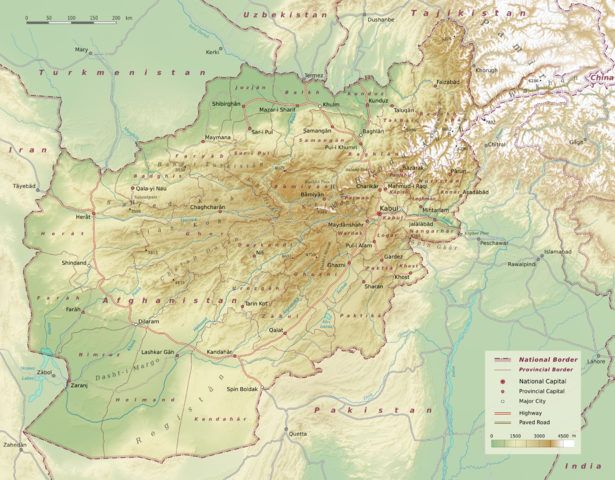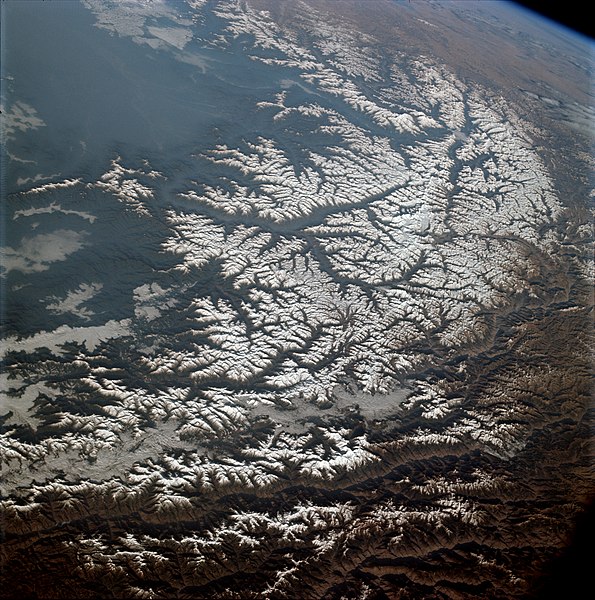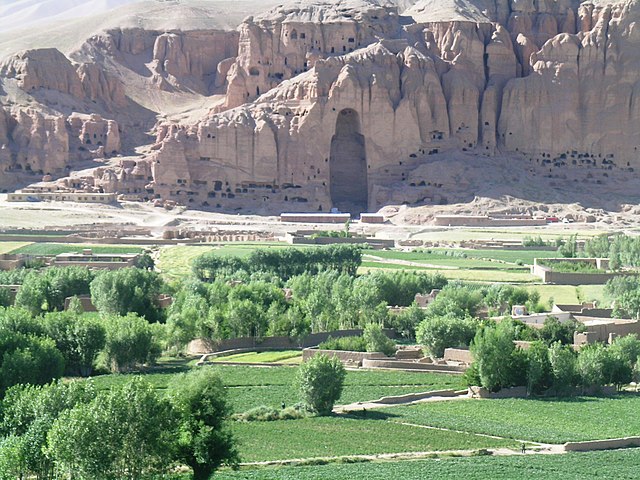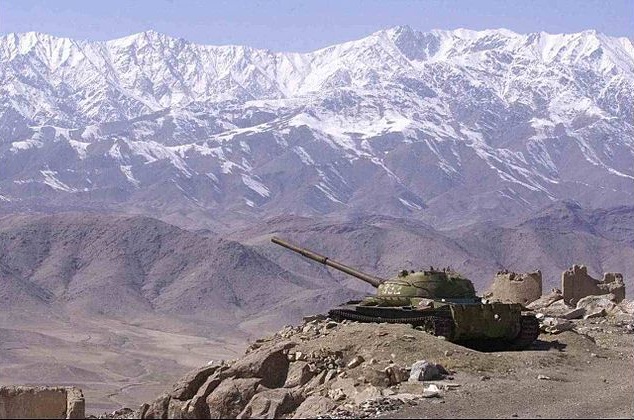
| HINDU KUSH
Topography of the Hindu Kush range Highest
point : Peak Tirich Mir (Pakistan)
Hindu Kush (top right) and its extending mountain ranges to the west The Hindu Kush (commonly understood to mean Killer of the Hindus, Killer of the Indians, or Hindu-Killer in Persian) is an 800-kilometre-long (500 mi) mountain range that stretches through Afghanistan, from its centre to Northern Pakistan and into Tajikistan. The range forms the western section of the Hindu Kush Himalayan Region (HKH) and is the westernmost extension of the Pamir Mountains, the Karakoram and the Himalayas. It divides the valley of the Amu Darya (the ancient Oxus) to the north from the Indus River valley to the south. The range has numerous high snow-capped peaks, with the highest point being Tirich Mir or Terichmir at 7,708 metres (25,289 ft) in the Chitral District of Khyber Pakhtunkhwa, Pakistan. To the north, near its northeastern end, the Hindu Kush buttresses the Pamir Mountains near the point where the borders of China, Pakistan and Afghanistan meet, after which it runs southwest through Pakistan and into Afghanistan near their border. The eastern end of the Hindu Kush in the north merges with the Karakoram Range. Towards its southern end, it connects with the Spin Ghar Range near the Kabul River.
The mountains have been associated with the legendary Alborz mountains of Iran in the Shahnameh. The Hindu Kush range region was a historically significant centre of Buddhism with sites such as the Bamiyan Buddhas. It remained a stronghold of polytheistic faiths until the 19th century. The range and communities settled in it hosted ancient monasteries, important trade networks and travellers between Central Asia and South Asia. The Hindu Kush range has also been the passageway during the invasions of the Indian subcontinent, and continues to be important during modern-era warfare in Afghanistan.
Etymology :
In the time of Alexander the Great, the Hindu Kush range was referred to as the Caucasus Indicus" (as opposed to the Greater Caucasus range between the Caspian and Black Seas). The mountain range was called "Paropamisadae" by Hellenic Greeks in the late first millennium BC. The earliest known usage of the name Hindu Kush occurs on a map published about 1000 CE.
A Persian-English dictionary indicates that the suffix 'koš' [koj] is the present stem of the verb "to kill" ('koštan'). According to Francis Joseph Steingass, the word and suffix "-kush" means "a male; (imp. of kushtan in comp.) a killer, who kills, slays, murders, oppresses as azhdaha-kush". According to one interpretation, the name Hindu Kush means "kills the Hindu" or "Hindu killer" and is a reminder of the days when slaves from the Indian subcontinent died in the harsh weather typical of the Afghan mountains while being taken to Central Asia. The World Book Encyclopedia states that the word kush means death, and was probably given to the mountains because of their dangerous passes.
In his travel memoirs about Khorasan, the 14th century Moroccan traveller Muhammad Ibn Battuta mentioned crossing into India via the mountain passes of the Hindu Kush. In his Rihla, he states that the name of the mountain range translates to "Hindu-slayer" due to slaves from India dying there. Alexander von Humboldt stated that it can be learned from his work that the name only referred to a single mountain pass upon which many Indian slaves died of the cold weather. Battuta wrote,
After this I proceeded to the city of Barwan, in the road to which is a high mountain, covered with snow and exceedingly cold; they call it the Hindu Kush, that is Hindu-slayer, because most of the slaves brought thither from India die on account of the intenseness of the cold.
—
Ibn Batutta, Chapter XIII, Rihla – Khorasan
Alternate
theories :
According to Nigel Allan, the term Hindu Kush has been commonly seen to mean "Hindu killer", but two alternate meanings are "sparkling snows of India" and "mountains of India" with "Kush" possibly a soft variant of Kuh which means "mountain". Another theory suggests the word "Hindu" in Hindu Kush is derived from the same root as "sindhu," meaning river, while Kush is a variant of the Persian word for mountain. Allan states that, to Arab geographers, Hindu Kush was the frontier boundary where Hindustan started. Another possibility is that the name may be from the ancient Avestan language, with the meaning "water mountain."
Other
names :
Some 19th century encyclopaedias and gazetteers state that the term Hindu Kush originally applied only to the peak in the area of the Kushan Pass, which had become a centre of the Kushan Empire by the first century. Some scholars remove the space, and refer to Hindu Kush as "Hindukush".
Geography
:
Peaks
:
Passes
:
Other mountain passes are at altitudes of about 3,700 m (12,000 ft) or higher, including the Broghil Pass at 12460 feet in Pakistan, and the Dorah Pass between Pakistan and Afghanistan at 14,000 feet. Other high passes in Pakistan include the Lowari Pass at 10,200 feet, the Gomal Pass.
Watershed
:
Climate
:
Geology :
The Hindu Kush photographed by Apollo 9 Geologically, the range is rooted in the formation of a subcontinent from a region of Gondwana that drifted away from East Africa about 160 million years ago, around the Middle Jurassic period. The Indian subcontinent, Australia and islands of the Indian Ocean rifted further, drifting northeastwards, with the Indian subcontinent colliding with the Eurasian Plate nearly 55 million years ago, towards the end of Palaeocene. This collision created the Himalayas, including the Hindu Kush.
The Hindu Kush are a part of the "young Eurasian mountain range consisting of metamorphic rocks such as schist, gneiss and marble, as well as of intrusives such as granite, diorite of different age and size". The northern regions of the Hindu Kush witness Himalayan winter and have glaciers, while its southeastern end witness the fringe of Indian subcontinent summer monsoons.
The Hindu Kush range remains geologically active and is still rising - it is prone to earthquakes. The Hindu Kush system stretches about 966 kilometres (600 mi) laterally, and its median north–south measurement is about 240 kilometres (150 mi).The mountains are orographically described in several parts. Peaks in the western Hindu Kush rise to over 5,100 m (16,700 ft) and stretches between Darra-ye Sekari and the Shibar Pass in the west and the Khawak Pass in the east. The central Hindu Kush peaks rise to over 6,800 m (22,300 ft), and this section has numerous spurs between the Khawak Pass in the east and the Durah Pass in the west.
The eastern Hindu Kush, also known as the "High Hindu Kush", is mostly located in northern Pakistan and the Nuristan and Badakhshan provinces of Afghanistanas with peaks over 7,000 m (23,000 ft). This section extends from the Durah Pass to the Baroghil Pass at the border between northeastern Afghanistan and north Pakistan. The Chitral District of Pakistan is home to Tirich Mir, Noshaq, and Istoro Nal - the highest peaks in the Hindu Kush. The ridges between Khawak Pass and Badakshan is over 5,800 m (19,000 ft) and is called the Kaja Mohammed range.
History :
Kabul, situated 5,900 feet (1,800 m) above sea level in a narrow valley, wedged between the Hindu Kush mountains The high altitudes of the mountains have historical significance in South and Central Asia. The Hindu Kush range was a major centre of Buddhism with sites such as the Bamiyan Buddhas. It has also been the passageway during the invasions of the Indian subcontinent, a region where the Taliban and Al Qaeda grew, and to modern era warfare in Afghanistan. In ancient mines producing lapis lazuli are found in Kowkcheh Valley, while gem-grade emeralds are found north of Kabul in the valley of the Panjsher River and some of its tributaries. According to Walter Schumann, the West Hindu Kush mountains have been the source of finest Lapis lazuli for thousands of years.
Buddhas of Bamiyan, Afghanistan in 1896 (top) and after destruction in 2001 by the Taliban Buddhism was widespread in the ancient Hindu Kush region. Ancient artwork of Buddhism include the giant rock carved statues called the Bamiyan Buddha, in the southern and western end of the Hindu Kush. These statues were blown up by the Taliban Islamists. The southeastern valleys of Hindu Kush connecting towards the Indus Valley region were a major centre that hosted monasteries, religious scholars from distant lands, trade networks and merchants of ancient Indian subcontinent.
One of the early Buddhist schools, the Mahasamghik-Lokottaravad, was prominent in the area of Bamiyan. The Chinese Buddhist monk Xuanzang visited a Lokottaravada monastery in the 7th century CE, at Bamiyan, Afghanistan. Birchbark and palm leaf manuscripts of texts in this monastery's collection, including Mahayana sutras, have been discovered in the caves of Hindu Kush, and these are now a part of the Schøyen Collection. Some manuscripts are in the Gandhari language and Kharo??hi script, while others are in Sanskrit and written in forms of the Gupta script.
According to Alfred Foucher, the Hindu Kush and nearby regions gradually converted to Buddhism by the 1st century CE, and this region was the base from where Buddhism crossed the Hindu Kush expanding into the Oxus valley region of Central Asia. Buddhism later disappeared and locals converted to Islam.
Richard Bulliet also proposes that the area north of Hindu Kush was centre of a new sect which had spread as far as Kurdistan, remaining in existence until the Abbasid times. The area eventually came under control of the Hindu Shahi dynasty of Kabul. The Islamic conquest of the area happened under Sabuktigin who conquered Jayapal's dominion west of Peshawar in 10th century.
Ancient
:
After Alexander the Great's death in 323 BCE, the region became part of the Seleucid Empire, according to the ancient history of Strabo written in 1st century BCE, before it became a part of the Indian Maurya Empire around 305 BCE. The region became a part of the Kushan Empire around the start of the common era.
Medieval
era :
Hindu Kush relative to Bactria, Bamiyan, Kabul and Gandhar (bottom right) The subcontinent and valleys of the Hindu Kush remained unconquered by the Islamic armies until the 9th century, even though they had conquered the southern regions of Indus River valley such as Sind. Kabul fell to the army of Al-Ma'mun, the seventh Abbasid caliph, in 808 and the local king agreed to accept Islam and pay annual tributes to the caliph. However, states André Wink, inscriptional evidence suggests that the Kabul area near Hindu Kush had an early presence of Islam.
The range came under control of the Hindu Shahi dynasty of Kabul but was conquered by Sabuktigin who took all of Jayapal's dominion west of Peshawar.
Mahmud of Ghazni came to power in 998 CE, in Ghazna, Afghanistan, south of Kabul and the Hindu Kush range. He began a military campaign that rapidly brought both sides of the Hindu Kush range under his rule. From his mountainous Afghani base, he systematically raided and plundered kingdoms in north India from east of the Indus river to west of Yamuna river seventeen times between 997 and 1030. Mahmud of Ghazni raided the treasuries of kingdoms, sacked cities, and destroyed Hindu temples, with each campaign starting every spring, but he and his army returned to Ghazni and the Hindu Kush base before monsoons arrived in the northwestern part of the subcontinent. He retracted each time, only extending Islamic rule into western Punjab.
In 1017, the Iranian Islamic historian Al-Biruni was deported after a war that Mahmud of Ghazni won, to the northwest Indian subcontinent under Mahmud's rule. Al Biruni stayed in the region for about fifteen years, learnt Sanskrit, and translated many Indian texts, and wrote about Indian society, culture, sciences, and religion in Persian and Arabic. He stayed for some time in the Hindu Kush region, particularly near Kabul. In 1019, he recorded and described a solar eclipse in what is the modern era Laghman Province of Afghanistan through which Hindu Kush pass.
Al Biruni also wrote about early history of the Hindu Kush region and Kabul kings, who ruled the region long before he arrived, but this history is inconsistent with other records available from that era. Al Biruni was supported by Sultan Mahmud. Al Biruni found it difficult to get access to Indian literature locally in the Hindu Kush area, and to explain this he wrote, "Mahmud utterly ruined the prosperity of the country, and performed wonderful exploits by which the Hindus became the atoms scattered in all directions, and like a tale of old in the mouth of the people.
This is the reason, too, why Hindu sciences have retired far from those parts of the country conquered by us, and have fled to places which our hand cannot yet reach, to Kashmir, Benares and other places".
In late 12th century, the historically influential Ghurid empire led by Mu'izz al-Din ruled the Hindu Kush region. He was influential in seeding the Delhi Sultanate, shifting the base of his Sultanate from south of the Hindu Kush range and Ghazni towards the Yamuna River and Delhi. He thus helped bring the Islamic rule to the northern plains of Indian subcontinent.
The Moroccan traveller Ibn Battuta arrived in the Delhi Sultanate by passing through the Hindu Kush. The mountain passes of the Hindu Kush range were used by Timur and his army and they crossed to launch the 1398 invasion of northern Indian subcontinent. Timur, also known as Temur or Tamerlane in Western scholarly literature, marched with his army to Delhi, plundering and killing all the way. He arrived in the capital Delhi where his army looted and killed its residents. Then he carried the wealth and the captured slaves, returning to his capital through the Hindu Kush.
Babur, the founder of Mughal Empire, was a patrilineal descendant of Timur with roots in Central Asia. He first established himself and his army in Kabul and the Hindu Kush region. In 1526, he made his move into north India, won the Battle of Panipat, ending the last Delhi Sultanate dynasty, and starting the era of the Mughals.
Slavery
:
According to John Coatsworth and others, the slave trading operations during the pre-Akbar Mughal and Delhi Sultanate era "sent thousands of Hindus every year north to Central Asia to pay for horses and other goods". However, the interaction between Central Asia and South Asia through the Hindu Kush was not limited to slavery, it included trading in food, goods, horses and weapons.
The practice of raiding tribes, hunting, and kidnapping people for slave trading continued through the 19th century, at an extensive scale, around the Hindu Kush. According to a British Anti-Slavery Society report of 1874, the governor of Faizabad, Mir Ghulam Bey, kept 8,000 horses and cavalry men who routinely captured non-Muslim infidels (kafir) as well as Shia Muslims as slaves. Others alleged to be involved in slave trade were feudal lords such as Ameer Sheer Ali. The isolated communities in the Hindu Kush were one of the targets of these slave hunting expeditions.
Modern era :
Landscape of Afghanistan with a T-62 in the foreground In early 19th century, the Sikh Empire expanded under Ranjit Singh in the northwest as far as the Hindu Kush range. The last polytheistic stronghold remained in the region until 1896, called "Kafiristan" whose people practised a form of polytheism (or were possibly nondenominational Muslims) until invasion and conversion at the hands of Afghans under Amir Abdur Rahman Khan.
The Hindu Kush served as a geographical barrier to the British empire, leading to paucity of information and scarce direct interaction between the British colonial officials and Central Asian peoples. The British had to rely on tribal chiefs, Sadozai and Barakzai noblemen for information, and they generally downplayed the reports of slavery and other violence for geo-political strategic considerations.
In the colonial era, the Hindu Kush were considered, informally, the dividing line between Russian and British areas of influence in Afghanistan. During the Cold War the Hindu Kush range became a strategic theatre, especially during the 1980s when Soviet forces and their Afghani allies fought the Mujahideen with support from the United States channelled through Pakistan. After the Soviet withdrawal and the end of the Cold War, many Mujahideen morphed into Taliban and Al Qaeda forces imposing a strict interpretation of Islamic law (Sharia), with Kabul, these mountains, and other parts of Afghanistan as their base. Other Mujahideen joined the Northern Alliance to oppose the Taliban rule.
After the 11 September 2001 terror attacks in New York City and Washington D.C., the American and ISAF campaign against Al Qaeda and their Taliban allies made the Hindu Kush once again a militarised conflict zone.
Ethnography
:
Source :
https://en.wikipedia.org/ |




_(14592652167).jpg)


